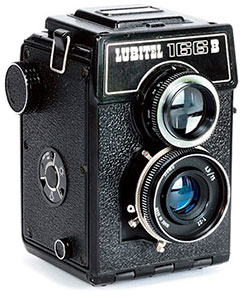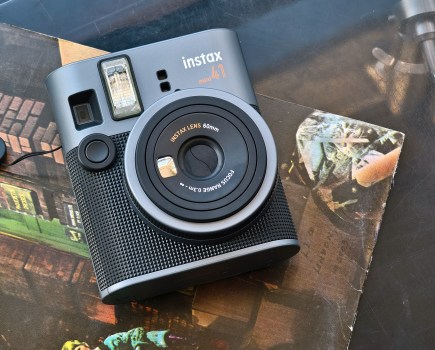Lomo Lubitel 166B
Price: £10-£40
 Lomo’s Lubitel 166B is an often-maligned plastic TLR that emerged from the Soviet Union in 1980. In essence, it’s a simplified version of the company’s original 166, which was designed to be cheaper to manufacture and buy. However, what you get for your money isn’t all bad. There’s a PC sync socket for flash, a 40.5mm filter thread, and although Lubitels are often associated with ‘toy cameras’, the 75mm triplet lens can produce a reasonable result.
Lomo’s Lubitel 166B is an often-maligned plastic TLR that emerged from the Soviet Union in 1980. In essence, it’s a simplified version of the company’s original 166, which was designed to be cheaper to manufacture and buy. However, what you get for your money isn’t all bad. There’s a PC sync socket for flash, a 40.5mm filter thread, and although Lubitels are often associated with ‘toy cameras’, the 75mm triplet lens can produce a reasonable result.
That said, it’s the lo-fi aspect that most are looking for when they choose a Lubitel, and the 166B is often happy to oblige: the red viewing window and plastic construction can result in light leaks; multiple exposures (both accidental and deliberate) are easy to achieve; and both focus and exposure can fall-off at the edges of the frame.
In recent years the original Russian cameras have suffered from the ‘halo effect’ of Lomography’s near-£300 Lubitel 166+, so while there are still £10 bargains to be had, they are fewer of them.
Rolleiflex 2.8F
Price: £800+
 The Rolleiflex 2.8F is widely regarded as the ‘Rolls-Royce’ of TLRs, with a build, finish and image quality that is hard to beat, let alone match (except, perhaps, with a Rolleiflex 3.5F). The 2.8F was announced in 1960 and came with the now legendary 80mm f/2.8 Zeiss Planar lens. Post-1966, 220 rollfilm could be used in addition to 120, and from 1973 a Schneider Xenotar lens of similar specification was fitted to most models. It’s worth noting that although the performance is considered equal (that is, outstanding), a 2.8F with a Schneider lens is usually less expensive than a Zeiss-equipped version.
The Rolleiflex 2.8F is widely regarded as the ‘Rolls-Royce’ of TLRs, with a build, finish and image quality that is hard to beat, let alone match (except, perhaps, with a Rolleiflex 3.5F). The 2.8F was announced in 1960 and came with the now legendary 80mm f/2.8 Zeiss Planar lens. Post-1966, 220 rollfilm could be used in addition to 120, and from 1973 a Schneider Xenotar lens of similar specification was fitted to most models. It’s worth noting that although the performance is considered equal (that is, outstanding), a 2.8F with a Schneider lens is usually less expensive than a Zeiss-equipped version.
Aside from its bitingly sharp lens, the vast majority of 2.8F cameras are fitted with a coupled, built-in lightmeter and all feature a depth-of-field indicator, filter compensation, multiple exposure facility, film detection that aligns the first frame automatically, and built-in parallax correction that ensures that what you see is what you get. In short, the Rolleiflex 2.8F is everything a TLR camera could – and should – be, although this is reflected in the price.
Yashica A
Price: £25-£50
 The Yashica A is a decidedly unremarkable camera, and the least expensive of four alphabetical models (A, B, C, and D) launched in the 1950s. This no-frills camera has a ‘bare-bones’ spec as befits its bottom-of-the-range status, with manual knob wind, manual shutter cocking, four shutter speeds (1/25sec, 1/50sec, 1/100sec and 1/300sec) and an 80mm f/3.5 Yashikor lens that lacks a filter mount. ‘Rudimentary’ best describes it.
The Yashica A is a decidedly unremarkable camera, and the least expensive of four alphabetical models (A, B, C, and D) launched in the 1950s. This no-frills camera has a ‘bare-bones’ spec as befits its bottom-of-the-range status, with manual knob wind, manual shutter cocking, four shutter speeds (1/25sec, 1/50sec, 1/100sec and 1/300sec) and an 80mm f/3.5 Yashikor lens that lacks a filter mount. ‘Rudimentary’ best describes it.
So why is it here? Well, if all you want to do is try a TLR, without breaking the bank or experiencing the lo-fi delights of a Lubitel, you can pay as little as £25 for a working example. As the A has the same triplet lens as its more expensive and refined siblings, it’s capable of turning in a reasonable result – it’s not exceptional, but it’s not bad, either. If it later transpires that a TLR isn’t for you, or you decide it is and you want something more refined, just sell it for as little as you paid and move on.
Minolta Autocord
Price: £80-£160
 It’s perhaps best to whisper it if you’re in earshot of Rollei enthusiasts, but some people say that Minolta’s Autocord comes close to matching the mighty Rolleiflex in terms of image quality. What is more surprising is that an original Autocord in working order can cost as little as £80 second-hand – that’s a lot of camera for the money if you’re more concerned about picture quality than brand name.
It’s perhaps best to whisper it if you’re in earshot of Rollei enthusiasts, but some people say that Minolta’s Autocord comes close to matching the mighty Rolleiflex in terms of image quality. What is more surprising is that an original Autocord in working order can cost as little as £80 second-hand – that’s a lot of camera for the money if you’re more concerned about picture quality than brand name.
As Ivor Matanle noted in his recent look at this iconic camera (Icons of photography, AP 30 March), all Autocords share the same high-quality, four-element 75mm f/3.5 Rokkor lens, so the specific model you choose is likely to come down to two things: do you want or need a built-in lightmeter, and do you want the option to shoot 220 film in addition to 120 film? If your answer to both of these is ‘no’, then an original Autocord is most suitable (the later, the better), while an Autocord CdS Model III will match your needs if you want a camera that has both of these features.
Zeiss-Ikon Ikoflex Favorit
Price: £250+
 Although a Zeiss lens is often cited as a key factor in a Rolleiflex’s greatness, Zeiss-Ikon itself couldn’t quite manage to produce a comparable camera. However, this is great in terms of buying second-hand, because the company’s Ikoflex models are typically engineered almost as well as the Rolleiflex and have picture quality surpassing that of a Rolleicord (and some say very close to the ‘Flex), but without the astronomical prices.
Although a Zeiss lens is often cited as a key factor in a Rolleiflex’s greatness, Zeiss-Ikon itself couldn’t quite manage to produce a comparable camera. However, this is great in terms of buying second-hand, because the company’s Ikoflex models are typically engineered almost as well as the Rolleiflex and have picture quality surpassing that of a Rolleicord (and some say very close to the ‘Flex), but without the astronomical prices.
The Ikoflex Favorit is the last of the line, and the most refined, although as production lasted just three years (1957-60) it’s not as prolific as other TLR makes and models. The Favorit’s bright viewfinder, 75mm f/3.5 Tessar lens and built-in meter make for a pleasant combination, although the ‘exposure computer’ can take a little getting used to. However, while a Favorit has the potential to offer plenty of performance for your pounds, its Achilles heel is the numerous ‘interlocks’ designed to prevent multiple exposures, blank frames, shooting without film, and so on. These can easily lead to a jammed shutter if something goes wrong – there’s a reason why they’re sometimes described as over-engineered, and many are sold for ‘spares or repair’.
Mamiya C330s
Price: £350-£450 with standard lens
 Although they are not the only TLRs with interchangeable lenses, the Mamiya C line-up is certainly the most pervasive, with seven lenses available covering focal lengths of 55-250mm. The all-manual C330, launched in 1969, is arguably the model responsible for the system’s popularity, and its rugged build and automatic parallax correction helped endear it to professionals looking for an affordable medium-format system camera.
Although they are not the only TLRs with interchangeable lenses, the Mamiya C line-up is certainly the most pervasive, with seven lenses available covering focal lengths of 55-250mm. The all-manual C330, launched in 1969, is arguably the model responsible for the system’s popularity, and its rugged build and automatic parallax correction helped endear it to professionals looking for an affordable medium-format system camera.
This means it’s fairly easy to get hold of a C330 kit second-hand, but given its professional past you need to be careful, especially if buying unseen. Generally, the last camera in the C330 line – the C330S – is the best buy, as it is not only the most robust, but was also produced at a time when professional photographers were being drawn towards more automated offerings, so is less likely to have seen such heavy use. As with previous versions, the C330S is compatible with the full range of C-system lenses (bar some of the earliest optics).








